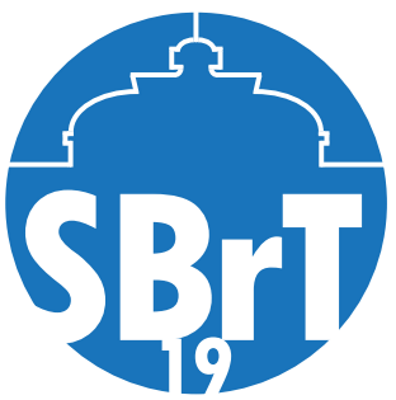
XXXVII Simpósio Brasileiro de Telecomunicações e Processamento de Sinais
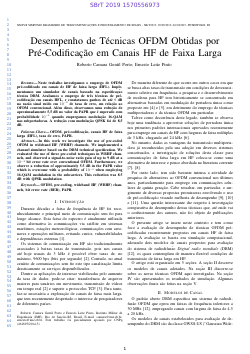
Desempenho de Técnicas OFDM Obtidas por Pré-Codificação em Canais HF de Faixa Larga
Roberto Porto, Ernesto L. Pinto
DOI: 10.14209/sbrt.2019.1570556973
Keywords:
Abstract
Neste trabalho investigamos o emprego de OFDM pré-codificados em canais de HF de faixa larga (HFL). Implementamos um simulador de canais baseado na especificação técnica DRM. Avaliamos o emprego de três técnicas em canais HFL, e constatamos ganhos de até 9 dB na razão sinal ruído (RSR) em 10e-4 de taxa de erro, em relação ao OFDM convencional. Além disso, observamos uma redução de aproximadamente 5,5 dB no valor da PAPR que é superado com probabilidade 10e-3 quando empregamos modulação 16-QAM nas subportadoras. A redução com modulação QPSK foi de 8,5 dB.Download

Estudo de predição de cobertura com aplicação em redes 5G
Daniel Pereira Gonçalves, Ugo Dias
DOI: 10.14209/sbrt.2019.1570556996
Keywords: 5G ERBs Potência Medições
Abstract
Este artigo apresenta uma predição de intensidade de sinal para redes 5G com base na infraestrutura de redes móveis atual. O objetivo é realizar uma análise preditiva do efeito da mudança de frequência sobre a qualidade da comunicação e verificar possíveis mudanças de infraestrutura que poderiam ser feitas com intuito de recuperar a qualidade de transmissão original observada na transmissão 4G.Download
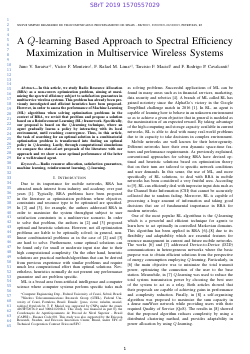
A Q-learning Based Approach to Spectral Efficiency Maximization in Multiservice Wireless Systems
Juno Saraiva, Victor Farias Monteiro, Francisco Rafael Marques Lima, Tarcisio F. Maciel, Francisco R. P. Cavalcanti
DOI: 10.14209/sbrt.2019.1570557029
Keywords:
Abstract
In this article, we study Radio Resource Allocation (RRA) as a non-convex optimization problem, in which the aim is to maximize the spectral efficiency subject to satisfaction guarantees in multiservice wireless systems. This problem has already been previously investigated in the literature and efficient heuristics have been proposed. However, in order to assess the performance of Machine Learning (ML) algorithms when solving optimization problems in the context of RRA, we revisit that problem and propose a solution based on a Reinforcement Learning (RL) framework. Specifically, our proposal is based on the Q-learning technique where an agent gradually learns a policy by interacting with its local environment, until reaching convergence. Thus, in this article, the task of searching for an optimal solution in a combinatorial optimization problem is transformed into finding an optimal policy in Q-learning. Lastly, through computational simulations we compare the state-of-art proposals of the literature with our approach and we show a near optimal performance of the latter for a well-trained agent.Download
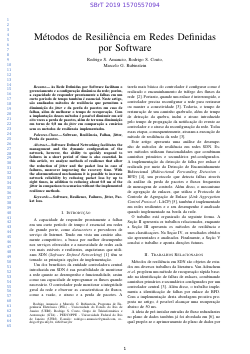
Métodos de Resiliência em Redes Definidas por Software
Rodrigo da Silva Amancio, Rodrigo S. Couto, Marcelo Gonçalves Rubinstein
DOI: 10.14209/sbrt.2019.1570557094
Keywords:
Abstract
Software Defined Networking facilitates the management and the dynamic configuration of the network, however, the ability to quickly respond to failures in a short period of time is also essential. In this article, we analyze methods of resilience that allow the reduction of jitter and the packet loss in case of failures, moreover improving the recovery time. With the aforementioned mechanisms it is possible to increase network reliability by reducing packet loss by up to eight times, in addition to reducing about 0.8 ms of the jitter in comparison to scenarios without the implemented resilience methods.Download

Estimation of Transfer Entropy for Capturing Connectivity and Causality in Industrial Processes
Micael Andrade Souza, M. Arruda, Francisco M. de Assis, Luciana Veloso
DOI: 10.14209/sbrt.2019.1570557119
Keywords:
Abstract
This paper discusses the use of two information theory measures: transfer entropy and direct transfer entropy, as an approach for detection of causality and connectivity between continuous variables in industrial processes (continuous systems). These measures are asymmetric and identify and quantify linear or non-linear directional relationships between two variables. To estimate these measures, we used estimators based on distances between neighbors. The results obtained from simulations demonstrate the applicability of the measurements and their estimations in order to identify the connectivity map of two systems: autoregressive model (which can be compared with the analytical results) and four water tanks (an industrial systems).Download
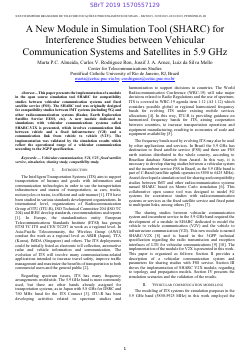
A New Module in Simulation Tool (SHARC) for Interference Studies between Vehicular Communication Systems and Satellites in 5.9 GHz
Marta Pudwell Chaves de Almeida, Carlos Rodriguez Ron, Luiz da Silva Mello, Jussif Junior Abularach Arnez
DOI: 10.14209/sbrt.2019.1570557129
Keywords:
Abstract
This paper presents the implementation of a module in the open source simulation tool SHARC for compatibility studies between vehicular communication systems and fixed satellite service (FSS). The SHARC tool originally was designed for compatibility studies between IMT systems (including 5G) and other radiocommunication systems (Radar, EESS, etc), and the new module called SHARC-V2X allows the simulation of vehicular communication system, which is composed by communication links between vehicles and a fixed infrastructure (V2I) and vehicles (V2V). The implementation was validated by the simulation results with reflect the operational range of a vehicular communication according to the 3GPP specification.Download

Melhoria da Atenuação Livre de Filtro rejeita-faixa compacto Matrioska a Partir da Aplicação de Ressonadores de Anéis Fendidos Complementares
Antonio Campos, João Alexandre da Silva Neto, Alfredo Neto, Ianes Coutinho
DOI: 10.14209/sbrt.2019.1570557196
Keywords:
Abstract
Este artigo propõe a melhoria de parâmetros de um filtro rejeita-faixa compacto baseado na geometria Matryoska. A melhoria dos parâmetros é conseguida a partir da modificação do plano de terra dos filtros analisados, pela inserção de ressonadores de anéis fendidos complementares (CSRR - Complementary Split-ring Resonators). São analisados filtros com CSRR circulares e retangulares. A inserção de CSRR circulares melhorou a atenuação livre, enquanto que a inserção de CSRR retangulares levou a uma melhoria da seletividade do filtro. São apresentados resultados numéricos e experimentais, observando-se uma boa concordância entre os mesmos.Download

Ambient Energy Harvesting: The Potential of Additive Noise in Urban and Rural Medium-Voltage Electric Power Networks
Victor Fernandes, Thiago Oliveira, Thiago Nogueira, Moises Vidal Ribeiro
DOI: 10.14209/sbrt.2019.1570557222
Keywords:
Abstract
This paper deals with the medium-voltage (MV) power line communication (PLC) in the context of energy harvesting. To do so, a measurement campaign was carried out in urban and rural environments of Curitiba city, Brazil. This measurement campaign estimated the MV-PLC additive noise in these electric power networks. Numerical results show that the power spectrum density and the mean power, for distinct RF-to-DC conversion factors, in the urban environment is higher than in the rural one. Also, the achievable data rate analysis over the MV electric power networks show the usefulness of this additive noise for feeding low-bit-rate devices.Download
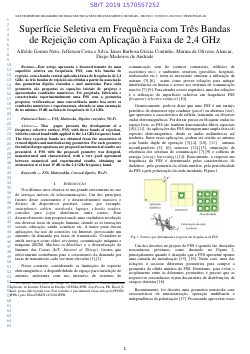
Superfície Seletiva em Frequência com Três Bandas de Rejeição com Aplicação à Faixa de 2,4 GHz
Alfredo Neto, Jefferson Costa Silva, Ianes Coutinho, Marina Alencar, Diego de Andrade
DOI: 10.14209/sbrt.2019.1570557252
Keywords:
Abstract
Este artigo apresenta o desenvolvimento de uma superfície seletiva em frequência, FSS, com três bandas de rejeição, com a banda central aplicada à faixa de frequência de 2,4 GHz. As três bandas de rejeição são obtidas a partir da associação das geometrias dipolos cruzados e anel matrioska. Para cada geometria são propostas as equações iniciais de projetos e apresentados resultados numéricos. Foi projetada, fabricada e caracterizada experimentalmente uma FSS com a geometria proposta, verificando-se uma concordância muito boa entre os resultados numéricos e experimentais, obtendo-se uma atenuação de no mínimo 15 dB na faixa de frequência de 2,4 GHz.Download
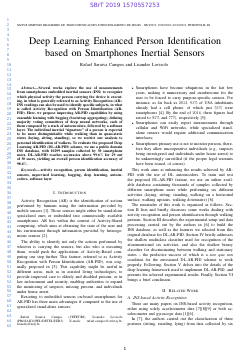
Deep Learning Enhanced Person Identification based on Smartphones Inertial Sensors
Rafael Saraiva Campos, Lisandro Lovisolo
DOI: 10.14209/sbrt.2019.1570557253
Keywords:
Abstract
Several works explore the use of measurements from smartphones embedded inertial sensors (INS) to recognize which physical activity the person carrying the device is executing, in what is generally referred to as Activity Recognition (AR). INS readings can also be used to identify specific subjects, in what is called Activity Recognition with Person Identification (ARPID). Here, we propose improving AR-PID capabilities by using ensemble learning with bagging (bootstrap aggregating), defining majority voting committees of deep neural networks, each of them composed by a stack of autoencoders, followed by a softmax layer. The individual inertial "signature" of a person is expected to be more distinguishable while walking than in quasi-static states (laying, sitting, standing), so we restrict our analysis to personal identification of walkers. To evaluate the proposed Deep Learning AR-PID (DL-AR-PID) scheme, we use a public domain INS database, with 10299 samples collected by 30 smartphone users. DL-AR-PID reaches accuracies above 99.6% for 29 out of 30 users, yielding an overall person identification accuracy of 98.6%.Download